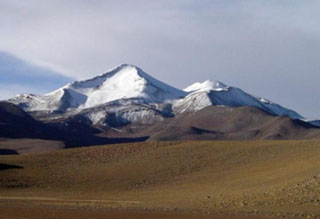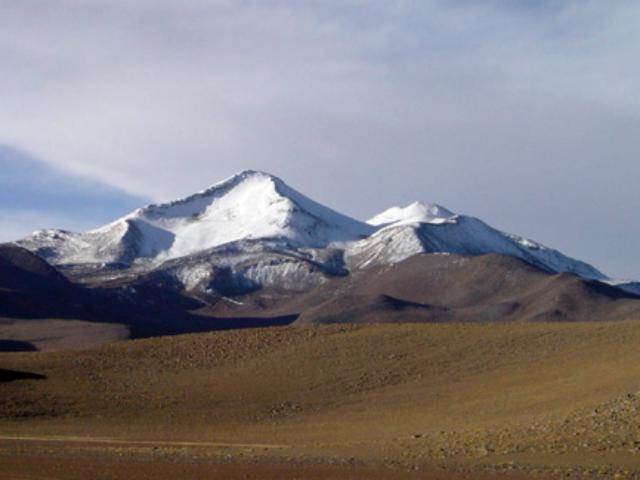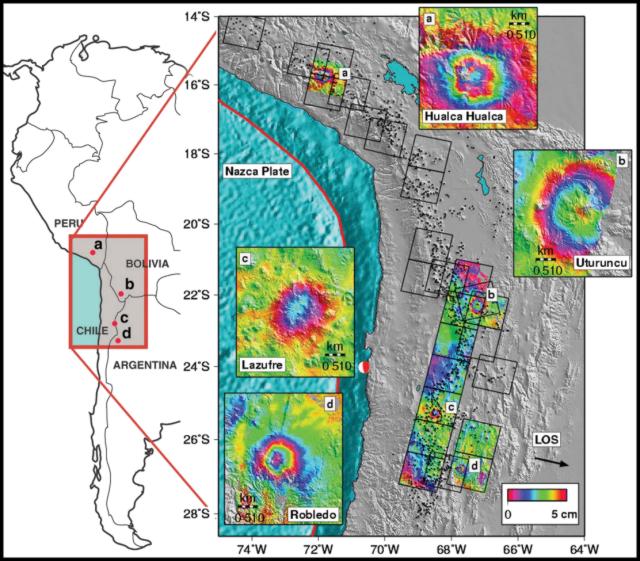Report on Uturuncu (Bolivia) — May 2003
Bulletin of the Global Volcanism Network, vol. 28, no. 5 (May 2003)
Managing Editor: Edward Venzke.
Uturuncu (Bolivia) Deformation detected by satellite surveys; low-level seismicity and active fumaroles
Please cite this report as:
Global Volcanism Program, 2003. Report on Uturuncu (Bolivia) (Venzke, E., ed.). Bulletin of the Global Volcanism Network, 28:5. Smithsonian Institution. https://doi.org/10.5479/si.GVP.BGVN200305-355838
Uturuncu
Bolivia
22.27°S, 67.18°W; summit elev. 6008 m
All times are local (unless otherwise noted)
A large-scale concentric pattern of deformation was detected between May 1996 and December 2000 centered on Uturuncu volcano, Bolivia (figure 1), based on satellite geodetic surveys (Pritchard and Simons, 2002). The observed deformation is primarily surface uplift with a maximum rate at the uplift center of 1-2 cm/year in the radar line-of-sight direction (figure 2). A reconnaissance investigation by a team composed of scientists from Bolivia, Chile, the USA, and the UK, took place during 1-6 April 2003 to identify any other signs of volcanic unrest and assess past volcanic behavior.
A single-component vertical one-second seismometer was placed at five locations for periods of up to 14 hours. Data were recorded at a rate of 100 samples per second on a laptop computer. Persistent low-level seismicity was observed mainly from one source location on the NW flank, close to the center of deformation observed by satellite surveys. Two other sources within the volcanic edifice could not be located with the available data. The rate of volcanic earthquakes was up to 15 per hour, and the magnitudes were in the 0.5-1.5 range based on coda length. The sources were considered to be within 3-4 km of the surface (much shallower than the deformation source); more accurate information will be available when the data are analyzed further.
The summit region of Uturuncu has two active fumarole fields with substantial sulfur production and areas of clay-silica hydrothermal alteration. Maximum temperatures in four fumaroles were measured at 79-80°C. A hot spring on the NW flanks had a temperature of 20°C.
Uturuncu is a stratovolcano composed of hypersthene andesites, hypersthene-biotite dacites, and biotite-hornblende dacites. Almost all the exposed products are extensive coulée-type lavas and domes; no pyroclastic deposits were observed. Flow features are well-preserved on the youngest lavas. A wide variety of xenoliths were found in most lavas, including mafic magmatic inclusions, cumulates, microcrystalline igneous inclusions, and hornfels of possible basement rocks including sandstones and calcareous rock types.
Lavas around the summit area appear to be the most recent products, but have been affected by glaciation; there is however no present-day ice. There is thus no evidence yet for Holocene activity. The recent unrest manifested by substantial ground deformation and reconnaissance seismicity indicate, however, that a magmatic system is still present and therefore further monitoring is warranted.
Reference. Pritchard, M., and Simons, M., 2002, A satellite geodetic survey of large-scale deformation of volcanic centres in the Central Andes: Nature, v. 418, p. 167-170.
Geological Summary. Uturuncu, located SE of Quetana, has two active sulfur-producing fumarole fields near the summit. Though postglacial lava flows were noted by Kussmaul et al. (1977), de Silva and Francis (1991) stated that inspection of satellite images showed no evidence for postglacial activity. Although lava flows display well-preserved flow features, youthful-looking summit flows show evidence of glaciation. Lava flows are mainly andesitic and dacitic, and no pyroclastic deposits have been reported. Large-scale ground deformation was observed beginning in May 1992 (Pritchard and Simons, 2002), indicating, along with seismicity detected in 2009-10 (Jay et al., 2012), that a magmatic system is still present.
Information Contacts: Mayel Sunagua and Ruben Muranca, Geological Survey of Bolivia, SERGEOMIN, Casilla 2729, La Paz, Bolivia; Jorge Clavero, Geological Survey of Chile, Servicio Nacional de Geología y Minería (SERGEOMIN), Avenida Santa María 0104, Casilla 10465, Santiago, Chile; Steve McNutt, Alaska Volcano Observatory and Geophysical Institute, University of Alaska Fairbanks, 903 Koyukuk Drive, PO Box 757320, Fairbanks, AK 99775-7320, USA (URL: http://www.avo.alaska.edu/); Matthew Pritchard, Division of Geological and Planetary Sciences, California Institute of Technology, Pasadena, CA 91125, USA (URL: http://www.gps.caltech.edu/); C. Annen, M. Humphreys, A. le Friant, and R.S.J. Sparks, Department of Earth Sciences, University of Bristol, Bristol BS8 1RJ, UK.



